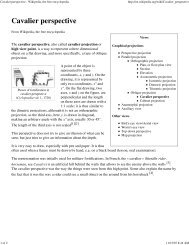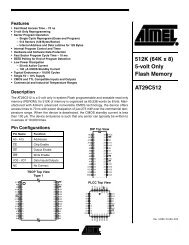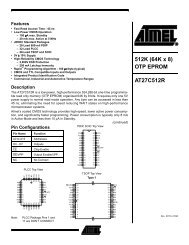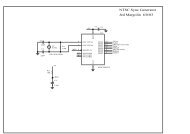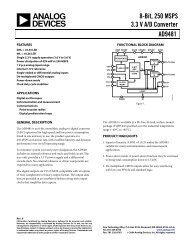Basic concepts of real-time operating systems
Basic concepts of real-time operating systems
Basic concepts of real-time operating systems
You also want an ePaper? Increase the reach of your titles
YUMPU automatically turns print PDFs into web optimized ePapers that Google loves.
Click here to learn<br />
about this Sponsor:<br />
home | news | articles | polls | forum | events | links | products | search<br />
Articles & white papers about Linux based embedded applications ...<br />
Keywords:<br />
Match: All keywords Search Sort by: Newest first <br />
by David Kalinsky (Nov. 18, 2003)<br />
The fundamentals<br />
<strong>Basic</strong> <strong>concepts</strong> <strong>of</strong> <strong>real</strong>-<strong>time</strong> <strong>operating</strong> <strong>systems</strong><br />
To most people, embedded <strong>systems</strong> are not recognizable as computers. Instead,<br />
they are hidden inside everyday objects that surround us and help us in our lives.<br />
Embedded <strong>systems</strong> typically do not interface with the outside world through<br />
familiar personal computer interface devices such as a mouse, keyboard and<br />
graphic user interface. Instead, they interface with the outside world through<br />
unusual interfaces such as sensors, actuators and specialized communication<br />
links.<br />
Real-<strong>time</strong> and embedded <strong>systems</strong> operate in constrained environments in which<br />
computer memory and processing power are limited. They <strong>of</strong>ten need to provide<br />
their services within strict <strong>time</strong> deadlines to their users and to the surrounding<br />
world. It is these memory, speed and timing constraints that dictate the use <strong>of</strong><br />
<strong>real</strong>-<strong>time</strong> <strong>operating</strong> <strong>systems</strong> in embedded s<strong>of</strong>tware.<br />
<strong>Basic</strong> kernel services<br />
In the discussion below, we will focus on the "kernel" ? the part <strong>of</strong> an <strong>operating</strong><br />
system that provides the most basic services to application s<strong>of</strong>tware running on a<br />
processor.<br />
Got a HOT tip? please tell us!<br />
Free weekly newsletter<br />
Enter your email...<br />
Subscribe<br />
Click here for a pr<strong>of</strong>ile <strong>of</strong> each sponsor:<br />
Platinum Sponsors:<br />
Gold Sponsors:<br />
(Become a sponsor)<br />
(Become a sponsor)<br />
The "kernel" <strong>of</strong> a <strong>real</strong>-<strong>time</strong> <strong>operating</strong> system ("RTOS") provides an "abstraction<br />
layer" that hides from application s<strong>of</strong>tware the hardware details <strong>of</strong> the processor<br />
(or set <strong>of</strong> processors) upon which the application s<strong>of</strong>tware will run. This is shown<br />
in Figure1.<br />
Figure 1: An RTOS Kernel provides an Abstraction Layer between<br />
Application S<strong>of</strong>tware and Embedded Hardware<br />
(Advertise here)<br />
In providing this "abstraction layer" the RTOS kernel supplies five main categories<br />
<strong>of</strong> basic services to application s<strong>of</strong>tware, as seen in Figure 2.<br />
Reference Guides<br />
• Embedded Linux distros<br />
• Real-<strong>time</strong> Linux<br />
• Embedded graphics<br />
• Embedded Java<br />
• Linux Devices Showcase<br />
• Little Linux <strong>systems</strong><br />
Check out the latest<br />
Linux-powered...<br />
http://linuxdevices.com/articles/AT4627965573... 1 <strong>of</strong> 9 4/15/07 11:26 AM
http://linuxdevices.com/articles/AT4627965573... 2 <strong>of</strong> 9 4/15/07 11:26 AM<br />
• Single board computers<br />
• Embedded processors<br />
• Embedded Linux books<br />
2006 Embedded Linux<br />
market snapshot:<br />
mobile<br />
phones!<br />
other cool<br />
gadgets<br />
...in our 2007 Embedded<br />
Linux Market Survey<br />
Figure 2: <strong>Basic</strong> Services Provided by a Real-Time Operating System Kernel<br />
The most basic category <strong>of</strong> kernel services, at the very center <strong>of</strong> Figure 2, is Task<br />
Management. This set <strong>of</strong> services allows application s<strong>of</strong>tware developers to<br />
design their s<strong>of</strong>tware as a number <strong>of</strong> separate "chunks" <strong>of</strong> s<strong>of</strong>tware -- each<br />
handling a distinct topic, a distinct goal, and perhaps its own <strong>real</strong>-<strong>time</strong> deadline.<br />
Each separate "chunk" <strong>of</strong> s<strong>of</strong>tware is called a "task." Services in this category<br />
include the ability to launch tasks and assign priorities to them. The main RTOS<br />
service in this category is the scheduling <strong>of</strong> tasks as the embedded system is in<br />
operation. The Task Scheduler controls the execution <strong>of</strong> application s<strong>of</strong>tware<br />
tasks, and can make them run in a very <strong>time</strong>ly and responsive fashion. [Later, we<br />
will see the details <strong>of</strong> how this is done.]<br />
The second category <strong>of</strong> kernel services, shown at the top <strong>of</strong> Figure 2, is Intertask<br />
Communication and Synchronization. These services make it possible for tasks to<br />
pass information from one to another, without danger <strong>of</strong> that information ever<br />
being damaged. They also make it possible for tasks to coordinate, so that they<br />
can productively cooperate with one another. Without the help <strong>of</strong> these RTOS<br />
services, tasks might well communicate corrupted information or otherwise<br />
interfere with each other.<br />
Since many embedded <strong>systems</strong> have stringent timing requirements, most RTOS<br />
kernels also provide some basic Timer services, such as task delays and<br />
<strong>time</strong>-outs. These are shown on the right side <strong>of</strong> Figure 2.<br />
Many (but not all) RTOS kernels provide Dynamic Memory Allocation services.<br />
This category <strong>of</strong> services allows tasks to "borrow" chunks <strong>of</strong> RAM memory for<br />
temporary use in application s<strong>of</strong>tware. Often these chunks <strong>of</strong> memory are then<br />
passed from task to task, as a means <strong>of</strong> quickly communicating large amounts <strong>of</strong><br />
data between tasks. Some very small RTOS kernels that are intended for tightly<br />
memory-limited environments, do not <strong>of</strong>fer Dynamic Memory Allocation services.<br />
BREAKING NEWS<br />
• 10 from IBM: Unix tasks, Time<br />
Base, LAMP, NFS, ActionScript<br />
3.0...<br />
• Report from the Embedded<br />
Systems Conference 2007<br />
• Sun acquires Java-based<br />
mobile phone OS<br />
• Mobile TV consensus<br />
emerging in Europe?<br />
• Compact Panel PC fits<br />
industrial embedded apps<br />
• Server device deemed "best<br />
Linux-based product"<br />
• Embedded s<strong>of</strong>tware pioneer<br />
stars in free webcasts<br />
• Chip-on-film mobile Linux core<br />
ships<br />
• First UMPC with Linux<br />
pre-installed?<br />
• Anatomy <strong>of</strong> a next-gen<br />
Linux-based network camera<br />
• Is the embedded industry<br />
dead?<br />
• Initiative targets COM<br />
Express interoperability<br />
• Palm fesses up to Linux Treo<br />
plans<br />
• OTA DTV standard targets<br />
mobile devices<br />
• Internet TV confab woos<br />
device specialists<br />
Don't miss the...<br />
Linux-Watch headlines:<br />
• Shuttleworth tips Ubuntu "Gutsy<br />
Gibbon" plans<br />
• Dear Mr. Gates: save Vista,<br />
open-source it<br />
• Are GPLv3 and Apache 2<br />
incompatible?<br />
• Clearing up the Novell ClearType<br />
controversy<br />
• RHEL Server 5 on the eWEEK<br />
Labs test bench<br />
• Reactions to Debian's v4.0<br />
release<br />
• Debian 4.0 finally arrives... does<br />
anyone care?<br />
• SCO, Pamela Jones, and money<br />
• Radiant Data launches 64-bit<br />
Linux HA replicating file system<br />
• SUSE Linux now available on<br />
Sun x64 workstations<br />
CAREER CENTER<br />
Search more than 60,000 tech<br />
jobs. Search by keywords, skill,<br />
job title, and location.<br />
Check it out today!<br />
"Website <strong>of</strong> the Year"<br />
Many (but not all) RTOS kernels also provide a "Device I/O Supervisor" category<br />
<strong>of</strong> services. These services, if available, provide a uniform framework for<br />
organizing and accessing the many hardware device drivers that are typical <strong>of</strong> an<br />
embedded system. [For more information on this, please visit: the device drivers<br />
page at the Kalinsky Associates Website]<br />
In addition to kernel services, many RTOSs <strong>of</strong>fer a number <strong>of</strong> optional add-on<br />
<strong>operating</strong> system components for such high-level services as file system<br />
organization, network communication, network management, database<br />
management, user-interface graphics, etc. Although many <strong>of</strong> these add-on<br />
components are much larger and much more complex than the RTOS kernel, they<br />
rely on the presence <strong>of</strong> the RTOS kernel and take advantage <strong>of</strong> its basic services.<br />
Each <strong>of</strong> these add-on components is included in an embedded system only if its<br />
services are needed for implementing the embedded application, in order to keep<br />
"Great Gadget<br />
Smack-Down"<br />
Also visit our sister site:<br />
Sign up for LinuxDevices.com's...<br />
SUBMISSIONS...<br />
Want to submit news,<br />
events, articles, resource<br />
links, product listings?<br />
Contact us here.
http://linuxdevices.com/articles/AT4627965573... 3 <strong>of</strong> 9 4/15/07 11:26 AM<br />
program memory consumption to a minimum.<br />
In this paper, we will focus on the basic RTOS kernel services for task<br />
management, intertask communication and synchronization, and dynamic memory<br />
allocation.<br />
RTOSs vs. general-purpose <strong>operating</strong> <strong>systems</strong><br />
Many non-<strong>real</strong>-<strong>time</strong> <strong>operating</strong> <strong>systems</strong> also provide similar kernel services. The<br />
key difference between general-computing <strong>operating</strong> <strong>systems</strong> and <strong>real</strong>-<strong>time</strong><br />
<strong>operating</strong> <strong>systems</strong> is the need for " deterministic " timing behavior in the<br />
<strong>real</strong>-<strong>time</strong> <strong>operating</strong> <strong>systems</strong>. Formally, "deterministic" timing means that <strong>operating</strong><br />
system services consume only known and expected amounts <strong>of</strong> <strong>time</strong>. In theory,<br />
these service <strong>time</strong>s could be expressed as mathematical formulas. These<br />
formulas must be strictly algebraic and not include any random timing<br />
components. Random elements in service <strong>time</strong>s could cause random delays in<br />
application s<strong>of</strong>tware and could then make the application randomly miss <strong>real</strong>-<strong>time</strong><br />
deadlines ? a scenario clearly unacceptable for a <strong>real</strong>-<strong>time</strong> embedded system.<br />
General-computing non-<strong>real</strong>-<strong>time</strong> <strong>operating</strong> <strong>systems</strong> are <strong>of</strong>ten quite<br />
non-deterministic. Their services can inject random delays into application<br />
s<strong>of</strong>tware and thus cause slow responsiveness <strong>of</strong> an application at unexpected<br />
<strong>time</strong>s. If you ask the developer <strong>of</strong> a non-<strong>real</strong>-<strong>time</strong> <strong>operating</strong> system for the<br />
algebraic formula describing the timing behavior <strong>of</strong> one <strong>of</strong> its services (such as<br />
sending a message from task to task), you will invariably not get an algebraic<br />
formula. Instead the developer <strong>of</strong> the non-<strong>real</strong>-<strong>time</strong> <strong>operating</strong> system (such as<br />
Windows, Unix or Linux) will just give you a puzzled look. Deterministic timing<br />
behavior was simply not a design goal for these general-computing <strong>operating</strong><br />
<strong>systems</strong>.<br />
On the other hand, <strong>real</strong>-<strong>time</strong> <strong>operating</strong> <strong>systems</strong> <strong>of</strong>ten go a step beyond basic<br />
determinism. For most kernel services, these <strong>operating</strong> <strong>systems</strong> <strong>of</strong>fer constant<br />
load-independent timing: In other words, the algebraic formula is as simple as:<br />
T(message_send) = constant , irrespective <strong>of</strong> the length <strong>of</strong> the message to be<br />
sent, or other factors such as the numbers <strong>of</strong> tasks and queues and messages<br />
being managed by the RTOS.<br />
Task scheduling<br />
Most RTOSs do their scheduling <strong>of</strong> tasks using a scheme called "priority-based<br />
preemptive scheduling." Each task in a s<strong>of</strong>tware application must be assigned a<br />
priority, with higher priority values representing the need for quicker<br />
responsiveness. Very quick responsiveness is made possible by the "preemptive"<br />
nature <strong>of</strong> the task scheduling. "Preemptive" means that the scheduler is allowed<br />
to stop any task at any point in its execution, if it determines that another task<br />
needs to run immediately.<br />
The basic rule that governs priority-based preemptive scheduling is that at every<br />
moment in <strong>time</strong>, "The Highest Priority Task that is Ready to Run, will be the Task<br />
that Must be Running." In other words, if both a low-priority task and a<br />
higher-priority task are ready to run, the scheduler will allow the higher-priority<br />
task to run first. The low-priority task will only get to run after the higher-priority<br />
task has finished with its current work.<br />
What if a low-priority task has already begun to run, and then a higher-priority task<br />
becomes ready? This might occur because <strong>of</strong> an external world trigger such as a<br />
switch closing. A priority-based preemptive scheduler will behave as follows: It will<br />
allow the low-priority task to complete the current assembly-language instruction<br />
that it is executing. [But it won?t allow it to complete an entire line <strong>of</strong> high-level<br />
language code; nor will it allow it to continue running until the next clock tick.] It<br />
will then immediately stop the execution <strong>of</strong> the low-priority task, and allow the<br />
higher-priority task to run. After the higher-priority task has finished its current<br />
work, the low-priority task will be allowed to continue running. This is shown in<br />
Figure 3, where the higher-priority task is called "Mid-Priority Task."<br />
news feed
http://linuxdevices.com/articles/AT4627965573... 4 <strong>of</strong> 9 4/15/07 11:26 AM<br />
Of course, while the mid-priority task is running, an even higher-priority task might<br />
become ready. This is represented in Figure 3 by "Trigger_2" causing the<br />
"High-Priority Task" to become ready. In that case, the running task ("Mid-Priority<br />
Task") would be preempted to allow the high-priority task to run. When the<br />
high-priority task has finished its current work, the mid-priority task would be<br />
allowed to continue. And after both the high-priority task and the mid-priority task<br />
complete their work, the low-priority task would be allowed to continue running.<br />
This situation might be called "nested preemption."<br />
Figure 3: Timeline for Priority-based Preemptive Scheduling Examples<br />
Each <strong>time</strong> the priority-based preemptive scheduler is alerted by an external world<br />
trigger (such as a switch closing) or a s<strong>of</strong>tware trigger (such as a message<br />
arrival), it must go through the following 5 steps:<br />
Determine whether the currently running task should continue to run. If not ?<br />
Determine which task should run next.<br />
Save the environment <strong>of</strong> the task that was stopped (so it can continue later).<br />
Set up the running environment <strong>of</strong> the task that will run next.<br />
Allow this task to run.<br />
These 5 steps together are called "task switching."<br />
Fixed-<strong>time</strong> task switching<br />
The <strong>time</strong> it takes to do task switching is <strong>of</strong> interest when evaluating an <strong>operating</strong><br />
system. A simple general-computing (non-preemptive) <strong>operating</strong> system might do<br />
task switching only at <strong>time</strong>r tick <strong>time</strong>s, which might for example be ten<br />
milliseconds apart. Then if the need for a task switch arises anywhere within a<br />
10-millisecond <strong>time</strong>frame, the actual task switch would occur only at the end <strong>of</strong><br />
the current 10-millisecond period. Such a delay would be unacceptable in most<br />
<strong>real</strong>-<strong>time</strong> embedded <strong>systems</strong>.<br />
In more sophisticated preemptive task schedulers, the scheduler may need to<br />
search through arrays <strong>of</strong> tasks to determine which task should be made to run<br />
next. If there are more tasks to search through, the search will take longer. Such<br />
searches are <strong>of</strong>ten done by general-computing <strong>operating</strong> <strong>systems</strong>, thus making<br />
them non-deterministic. Real-<strong>time</strong> <strong>operating</strong> <strong>systems</strong>, on the other hand, avoid<br />
such searches by using incrementally updated tables that allow the task scheduler<br />
to identify the task that should run next in a rapid fixed-<strong>time</strong> fashion.<br />
These two types <strong>of</strong> timing behavior for task switching can be seen in Figure 4.
http://linuxdevices.com/articles/AT4627965573... 5 <strong>of</strong> 9 4/15/07 11:26 AM<br />
Figure 4: Task Switching Timing<br />
In this figure, we see that for a general-computing (non-<strong>real</strong>-<strong>time</strong>) <strong>operating</strong><br />
system, the task switching <strong>time</strong> generally rises as a s<strong>of</strong>tware system includes<br />
more tasks that can be scheduled. However, the actual <strong>time</strong> for a task switch is<br />
not the <strong>time</strong> shown by the dashed red line. Instead, in any given task switch<br />
instance, it might be well above or well below the <strong>time</strong> shown by the dashed red<br />
line. The shaded regions surrounding the dashed red line simply show the<br />
likelihood <strong>of</strong> the actual task switch <strong>time</strong> being that far above or below the dashed<br />
red line.<br />
On the other hand, the horizontal solid green line shows the task switching <strong>time</strong><br />
characteristic <strong>of</strong> a <strong>real</strong>-<strong>time</strong> <strong>operating</strong> system. It is constant, independent <strong>of</strong> any<br />
load factor such as the number <strong>of</strong> tasks in a s<strong>of</strong>tware system.<br />
Please note that in some instances, such as the leftmost area <strong>of</strong> the graph, the<br />
task switching <strong>time</strong> might in special cases be quicker for a general-computing<br />
non-<strong>real</strong>-<strong>time</strong> <strong>operating</strong> system, than for a <strong>real</strong>-<strong>time</strong> <strong>operating</strong> system. This does<br />
not detract from the appropriateness <strong>of</strong> a <strong>real</strong>-<strong>time</strong> <strong>operating</strong> system for <strong>real</strong>-<strong>time</strong><br />
embedded applications. For, in fact, the term "<strong>real</strong>-<strong>time</strong>" does not mean "as fast<br />
as possible" but rather "<strong>real</strong>-<strong>time</strong>" demands consistent, repeatable, known timing<br />
performance. Although a non-<strong>real</strong>-<strong>time</strong> <strong>operating</strong> system might do some faster<br />
task switching for small numbers <strong>of</strong> tasks, it might equally well introduce a long<br />
<strong>time</strong> delay the next <strong>time</strong> it does the same task switch. The strength <strong>of</strong> a <strong>real</strong>-<strong>time</strong><br />
<strong>operating</strong> system is in its known, repeatable timing performance, which is also<br />
typically faster than that <strong>of</strong> a non-deterministic task scheduler in situations <strong>of</strong> large<br />
numbers <strong>of</strong> tasks in a s<strong>of</strong>tware system. Most <strong>of</strong>ten, the <strong>real</strong>-<strong>time</strong> <strong>operating</strong> system<br />
will exhibit task-switching <strong>time</strong>s much faster than its non-<strong>real</strong>-<strong>time</strong> competitor<br />
when the number <strong>of</strong> tasks grows above 5 or 10.<br />
Intertask communication and synchronization<br />
Most <strong>operating</strong> <strong>systems</strong>, including RTOSs, <strong>of</strong>fer a variety <strong>of</strong> mechanisms for<br />
communication and synchronization between tasks. These mechanisms are<br />
necessary in a preemptive environment <strong>of</strong> many tasks, because without them the<br />
tasks might well communicate corrupted information or otherwise interfere with<br />
each other.<br />
For instance, a task might be preempted when it is in the middle <strong>of</strong> updating a<br />
table <strong>of</strong> data. If a second task that preempts it reads from that table, it will read a<br />
combination <strong>of</strong> some areas <strong>of</strong> newly-updated data plus some areas <strong>of</strong> data that<br />
have not yet been updated. [New Yorkers would call this a "mish-mash."] These<br />
updated and old data areas together may be incorrect in combination, or may not<br />
even make sense. An example is a data table containing temperature<br />
measurements that begins with the contents "10 C." A task begins updating this<br />
table with the new value "99 F", writing into the table character-by-character. If<br />
that task is preempted in the middle <strong>of</strong> the update, a second task that preempts it
http://linuxdevices.com/articles/AT4627965573... 6 <strong>of</strong> 9 4/15/07 11:26 AM<br />
could possibly read a value like "90 C" or "99 C." or "99 F", depending on<br />
precisely when the preemption took place. The partially updated values are clearly<br />
incorrect, and are caused by delicate timing coincidences that are very hard to<br />
debug or reproduce consistently.<br />
An RTOS's mechanisms for communication and synchronization between tasks<br />
are provided to avoid these kinds <strong>of</strong> errors. Most RTOSs provide several<br />
mechanisms, with each mechanism optimized for reliably passing a different kind<br />
<strong>of</strong> information from task to task.<br />
Probably the most popular kind <strong>of</strong> communication between tasks in embedded<br />
<strong>systems</strong> is the passing <strong>of</strong> data from one task to another. Most RTOSs <strong>of</strong>fer a<br />
message passing mechanism for doing this, as seen in Figure 5. Each message<br />
can contain an array or buffer <strong>of</strong> data.<br />
Figure 5: Intertask Message Communication<br />
If messages can be sent more quickly than they can be handled, the RTOS will<br />
provide message queues for holding the messages until they can be processed.<br />
This is shown in Figure6.<br />
Another kind <strong>of</strong> communication between tasks in embedded <strong>systems</strong> is the<br />
passing <strong>of</strong> what might be called "synchronization information" from one task to<br />
another. "Synchronization information" is like a command, where some<br />
commands could be positive, and some negative. For example, a negative<br />
command to a task would be something like "Please don?t print right now,<br />
because my task is using the printer." Or more generally, "I want to lock the . . .<br />
for my own use only." A positive command would be something like "I?ve detected<br />
a cardiac emergency, and I want you to help me handle it." Or more generally,<br />
"Please join me in handling . . ."<br />
Most RTOSs <strong>of</strong>fer a semaphore or mutex mechanism for handling negative<br />
synchronization (some<strong>time</strong>s called "mutual exclusion"). These mechanisms allow<br />
tasks to lock certain embedded system resources for their use only, and<br />
subsequently to unlock the resource when they?re done.<br />
For positive synchronization, different RTOSs <strong>of</strong>fer different mechanisms. Some<br />
RTOSs <strong>of</strong>fer event-flags, while others <strong>of</strong>fer signals. And yet others rely on<br />
message passing for positive synchronization as well as data passing duties.<br />
Determinism and high-speed message passing<br />
Intertask message communication is another area where different <strong>operating</strong><br />
<strong>systems</strong> show different timing characteristics. Most <strong>operating</strong> <strong>systems</strong> actually<br />
copy messages twice as they transfer them from task to task via a message<br />
queue. See Figure 6. The first copying is from the message-sender task to an<br />
<strong>operating</strong> system-owned "secret" area <strong>of</strong> RAM memory (implementing the<br />
"message queue"); and the second copying is from the <strong>operating</strong> system?s<br />
"secret" RAM area to the message-receiver task. Clearly this is non-deterministic<br />
in its timing, as these copying activities take longer as message length increases.<br />
Figure 6: Message Transfer via Message Queue<br />
An approach that avoids this non-determinism and also accelerates performance,<br />
is to have the <strong>operating</strong> system copy a pointer to the message and deliver that<br />
pointer to the message-receiver task without moving the message contents at all.<br />
In order to avoid access collisions, the <strong>operating</strong> system then needs to go back to
http://linuxdevices.com/articles/AT4627965573... 7 <strong>of</strong> 9 4/15/07 11:26 AM<br />
the message-sender task and obliterate its copy <strong>of</strong> the pointer to the message.<br />
For large messages, this eliminates the need for lengthy copying and eliminates<br />
non-determinism.<br />
Dynamic memory allocation<br />
Determinism <strong>of</strong> service <strong>time</strong>s is also an issue in the area <strong>of</strong> dynamic allocation <strong>of</strong><br />
RAM memory. Many general-computing non-<strong>real</strong>-<strong>time</strong> <strong>operating</strong> <strong>systems</strong> <strong>of</strong>fer<br />
memory allocation services from what is termed a "Heap." The famous "malloc"<br />
and "free" services known to C-language programmers work from a heap. Tasks<br />
can temporarily borrow some memory from the <strong>operating</strong> system?s heap by<br />
calling "malloc", and specifying the size <strong>of</strong> memory buffer needed. When this task<br />
(or another task) is finished with this memory buffer it can return the buffer to the<br />
<strong>operating</strong> system by calling "free." The <strong>operating</strong> system will then return the buffer<br />
to the heap, where its memory might be used again, perhaps as part <strong>of</strong> a larger<br />
buffer. Or perhaps it may in the future be broken into several smaller buffers.<br />
Heaps suffer from a phenomenon called "External Memory Fragmentation" that<br />
may cause the heap services to degrade. This fragmentation is caused by the fact<br />
that when a buffer is returned to the heap, it may in the future be broken into<br />
smaller buffers when "malloc" requests for smaller buffer sizes occur. After a heap<br />
undergoes many cycles <strong>of</strong> "malloc"s and "free"s, small slivers <strong>of</strong> memory may<br />
appear between memory buffers that are being used by tasks. These slivers are<br />
so small that they are useless to tasks. But they are trapped between buffers that<br />
are being used by tasks, so they can?t be coagulated ("glued") together into<br />
bigger, useful buffer sizes. Over <strong>time</strong>, a heap will have more and more <strong>of</strong> these<br />
slivers. This will eventually result in situations where tasks will ask for memory<br />
buffers ("malloc") <strong>of</strong> a certain size, and they will be refused by the <strong>operating</strong><br />
system --- even though the <strong>operating</strong> system has enough available memory in its<br />
heap. The problem: That memory is scattered in small slivers distributed in<br />
various separate parts <strong>of</strong> the heap. In <strong>operating</strong> system terminology, the slivers<br />
are called "fragments", and this problem is called "external memory<br />
fragmentation."<br />
This fragmentation problem can be solved by so-called "garbage collection"<br />
(defragmentation) s<strong>of</strong>tware. Unfortunately, "garbage collection" algorithms are<br />
<strong>of</strong>ten wildly non-deterministic ? injecting randomly-appearing random-duration<br />
delays into heap services. These are <strong>of</strong>ten seen in the memory allocation services<br />
<strong>of</strong> general-computing non-<strong>real</strong>-<strong>time</strong> <strong>operating</strong> <strong>systems</strong>.<br />
This puts the embedded system developer who wants to use a general-computing<br />
non-<strong>real</strong>-<strong>time</strong> <strong>operating</strong> system into a quandry: Should the embedded system be<br />
allowed to suffer occasional randomly-appearing random-duration delays if / when<br />
"garbage collection" kicks in?... Or, alternatively, should the embedded system be<br />
allowed to fragment its memory until application s<strong>of</strong>tware "malloc" requests to the<br />
heap are refused even though a sufficient total amount <strong>of</strong> free memory is still<br />
available? Neither alternative is acceptable for embedded <strong>systems</strong> that need to<br />
provide service continually for long periods <strong>of</strong> <strong>time</strong>.<br />
Real-<strong>time</strong> <strong>operating</strong> <strong>systems</strong>, on the other hand, solve this quandry by altogether<br />
avoiding both memory fragmentation and "garbage collection", and their<br />
consequences. RTOSs <strong>of</strong>fer non-fragmenting memory allocation techniques<br />
instead <strong>of</strong> heaps. They do this by limiting the variety <strong>of</strong> memory chunk sizes they<br />
make available to application s<strong>of</strong>tware. While this approach is less flexible than<br />
the approach taken by memory heaps, they do avoid external memory<br />
fragmentation and avoid the need for defragmentation. For example, the "Pools"<br />
memory allocation mechanism allows application s<strong>of</strong>tware to allocate chunks <strong>of</strong><br />
memory <strong>of</strong> perhaps 4 or 8 different buffer sizes per pool. Pools totally avoid<br />
external memory fragmentation, by not permitting a buffer that is returned to the<br />
pool to be broken into smaller buffers in the future. Instead, when a buffer is<br />
returned the pool, it is put onto a "free buffer list" <strong>of</strong> buffers <strong>of</strong> its own size that are<br />
available for future re-use at their original buffer size. This is shown in Figure 7.
http://linuxdevices.com/articles/AT4627965573... 8 <strong>of</strong> 9 4/15/07 11:26 AM<br />
Figure 7: A Memory Pool's Free Buffer Lists<br />
Memory is allocated and de-allocated from a pool with deterministic, <strong>of</strong>ten<br />
constant, timing.<br />
Summary<br />
Real-<strong>time</strong> and embedded <strong>systems</strong> are used in many applications such as airborne<br />
computers, medical instruments and communication <strong>systems</strong>. Embedded <strong>systems</strong><br />
are characterized by limited processor memory, limited processing power, and<br />
unusual interfaces to the outside world. Real-<strong>time</strong> requirements impose stringent<br />
<strong>time</strong> deadlines for delivering the results <strong>of</strong> embedded processing.<br />
RTOS kernels hide from application s<strong>of</strong>tware the low-level details <strong>of</strong> system<br />
hardware, and at the same <strong>time</strong> provide several categories <strong>of</strong> services to<br />
application s<strong>of</strong>tware. These include: task management with priority-based<br />
preemptive scheduling, reliable intertask communication and synchronization,<br />
non-fragmenting dynamic memory allocation, and basic <strong>time</strong>r services.<br />
The issue <strong>of</strong> timing determinism is important in differentiating general-computing<br />
<strong>operating</strong> <strong>systems</strong> from <strong>real</strong>-<strong>time</strong> <strong>operating</strong> <strong>systems</strong>. This issue crops up in many<br />
parts <strong>of</strong> <strong>operating</strong> system kernels, such as task schedulers, dynamic memory<br />
allocation and intertask message communication. While general-computing<br />
<strong>operating</strong> <strong>systems</strong> <strong>of</strong>ten <strong>of</strong>fer non-deterministic services in these areas, fully<br />
deterministic solutions are needed for <strong>real</strong>-<strong>time</strong> and embedded <strong>systems</strong>. A<br />
number <strong>of</strong> <strong>real</strong>-<strong>time</strong> <strong>operating</strong> <strong>systems</strong> implement these solutions in their compact<br />
high-performance kernels.<br />
About the author: David Kalinsky is a popular lecturer and seminar<br />
leader on technologies for embedded s<strong>of</strong>tware. He regularly<br />
presents classes at the Embedded Systems Conferences in the US<br />
and Europe, on topics such as "Architectural Design <strong>of</strong> Device I/O<br />
Drivers," and "Principles <strong>of</strong> High-Availability Embedded Systems<br />
Design." During the past 15 years, David has built high-tech training<br />
programs for a number <strong>of</strong> Silicon Valley companies on the<br />
development <strong>of</strong> <strong>real</strong>-<strong>time</strong> and embedded <strong>systems</strong>. Before that, he was involved in<br />
the design <strong>of</strong> embedded medical and aerospace <strong>systems</strong>. David holds a Ph.D. in<br />
nuclear physics from Yale. He can be reached at david@kalinskyassociates.com.<br />
An online sample lecture, course list, schedule, and price list are available on the<br />
Kalinsky Associates Website.<br />
Copyright ? 2004, D. Kalinsky Associates; all rights reserved. Reproduced by<br />
LinuxDevices.com with permission.
http://linuxdevices.com/articles/AT4627965573... 9 <strong>of</strong> 9 4/15/07 11:26 AM<br />
Related Stories:<br />
Introducing MediaLinux -- a new <strong>real</strong>-<strong>time</strong> Linux approach<br />
The Real-<strong>time</strong> Linux S<strong>of</strong>tware Quick Reference Guide<br />
34 papers on <strong>real</strong>-<strong>time</strong> Linux -- proceedings <strong>of</strong> the 4th Real-<strong>time</strong> Linux<br />
Workshop<br />
28 talks on <strong>real</strong>-<strong>time</strong> Linux<br />
Update: Real-<strong>time</strong> Linux sub-kernels, benchmarks, and . . . contention<br />
Kevin Dankwardt on Real Time and Linux (Part 1)<br />
Kevin Dankwardt on Real Time and Linux (Part 2)<br />
Kevin Dankwardt on Real Time and Linux (Part 3)<br />
Real-<strong>time</strong> Linux -- what is it, why do you want it, how do you do it?<br />
Comparing <strong>real</strong>-<strong>time</strong> Linux alternatives<br />
Fundamentals <strong>of</strong> Real-<strong>time</strong> Linux S<strong>of</strong>tware Design<br />
)UHH:LQGRZV9LVWDŠ<br />
*HWD)UHH&RS\RI0LFURVRIW9LVWDŠ$FW1RZ)UHH2IIHU(QGV7RGD\<br />
ZZZ)UHH6RIWZDUH*LIWVFRP<br />
)UHH:LQGRZV;38SJUDGH<br />
*HWD)UHH:LQGRZV9LVWD2IIHU([SLUHV7RGD\<br />
ZZZDOZD\VIUHHJLIWVFRP<br />
3XUH'26<br />
7KLV&'+DV$OO'26)XQFWLRQV:LWK0RGHUQ8VHU,QWHUIDFH<br />
ZZZVSRWPDXFRP<br />
2SHUDWLQJ6\VWHP&RXUVH<br />
0RYH\RXUFDUHHUIRUZDUGZLWKDQDFFUHGLWHGRQOLQHGHJUHH<br />
ZZZ&RXUVH$GYLVRUFRP<br />
)L[:LQGRZV(UURUV<br />
'RZQORDGD)UHH6FDQDQG)L[3&(UURUV,QVWDQWO\<br />
ZZZ7XQHXS$GYLVRUFRP<br />
$GV%\*RRJOH<br />
Find out how to put your company's message here<br />
home | news | articles | polls | forum | events | links | products | search | aboutus | contactus<br />
Use <strong>of</strong> this site is governed by our Terms <strong>of</strong> Use and Privacy Policy. Except where otherwise specified, the contents <strong>of</strong> this site are<br />
copyright © 1999-2007 Ziff Davis Publishing Holdings Inc. All Rights Reserved. Reproduction in whole or in part without permission is<br />
prohibited. Linux is a registered trademark <strong>of</strong> Linus Torvalds. All other marks are the property <strong>of</strong> their respective owners.



